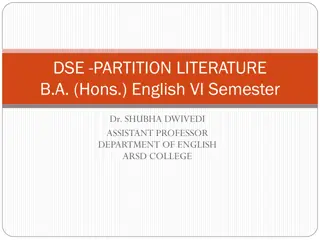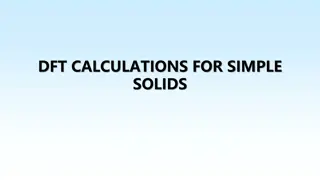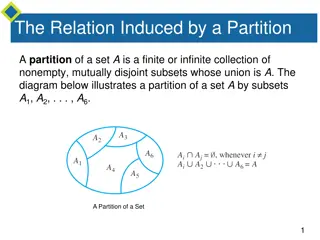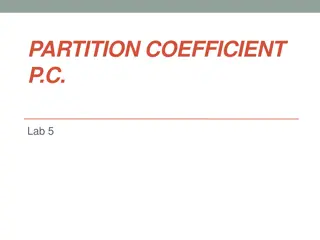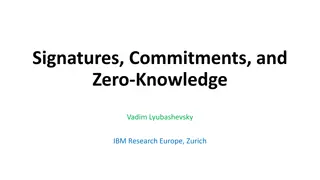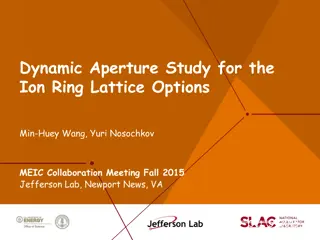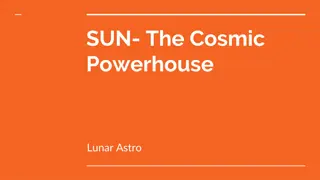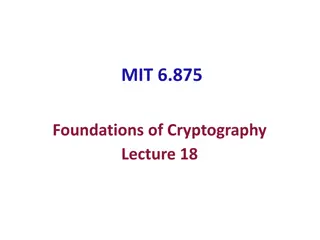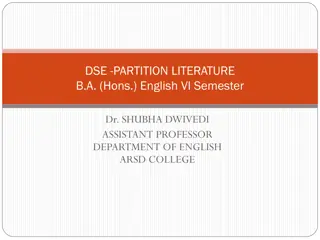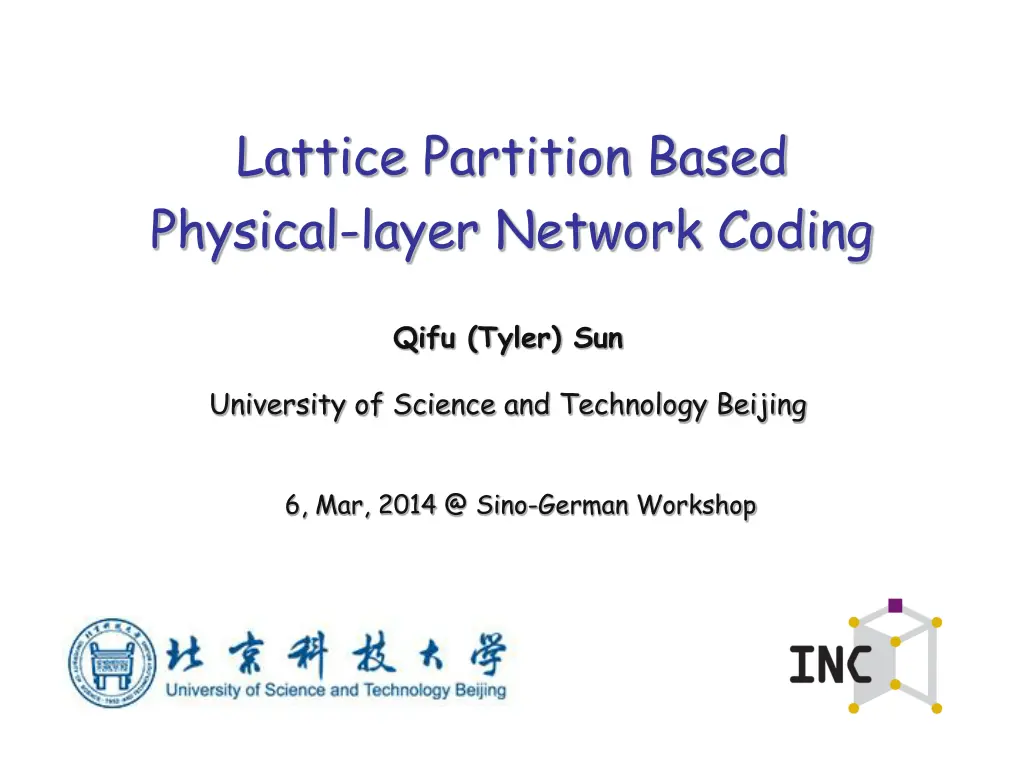
Lattice Partition Based Physical Layer Network Coding Overview
Explore the concept of lattice partition-based physical-layer network coding, its applications, and modulation schemes. Learn about the benefits of using lattice partition structures for reliable PNC over finite fields.
Download Presentation

Please find below an Image/Link to download the presentation.
The content on the website is provided AS IS for your information and personal use only. It may not be sold, licensed, or shared on other websites without obtaining consent from the author. If you encounter any issues during the download, it is possible that the publisher has removed the file from their server.
You are allowed to download the files provided on this website for personal or commercial use, subject to the condition that they are used lawfully. All files are the property of their respective owners.
The content on the website is provided AS IS for your information and personal use only. It may not be sold, licensed, or shared on other websites without obtaining consent from the author.
E N D
Presentation Transcript
Lattice Partition Based Physical-layer Network Coding Qifu (Tyler) Sun University of Science and Technology Beijing 6, Mar, 2014 @ Sino-German Workshop
References B. Nazer and M. Gastpar, Reliable physical layer network coding, Proceedings of the IEEE, vol. 99, no. 3, Mar., 2011. C. Feng, D. Silva, and F. R. Kschischang, An algebraic approach to physical-layer network coding, IEEE Transactions on Information Theory, vol. 59, pp. 7576-7596, no. 11, Nov. 2013. Q. T. Sun, J. Yuan, T. Huang and W. K. Shum, Lattice network codes based on Eisenstein integers, IEEE Transactions on Communications, vol. 61, no. 7, Jul., 2013. 2
Physical-layer Network Coding (PNC) yR= xA+xB x x A B x x R R w w w w w w w w B B A A B B A A F Relay computes the modulo-two sum wA wB from linearly superimposed receiving signals yR= xA+xB C Enhances the throughput of a binary-input TWRC. [Nam-Chung-Lee 10]roach the capacity upper bound of a Gaus 1. Zhang-Liew-Lam, Hot topic: physical layer network coding, MobiCom, 2006. 2. Popviski-Yomo, The anti-packets can increase the achievable throughput of a wireless multi-hop network, ICC, 2006. 3. Nazer-Gastpar, ,Computing over multiple-access channels with connections to wireless network coding, ISIT, 2006.. 3
Physical-layer Network Coding (PNC) yR= hAxA+ hBxB x x A B x x R R w w w w w w aAwA+aBwB w w B B A A B B A A Relay computes the F-linear combination of aAwA+aBwB from linearly superimposed receiving signals yR= hAxA+ hBxB [Nam-Chung-Lee 10]roach the capacity upper bound of a Gaus 1.We need an appropriate modulation scheme to map linearity from over complex number field to over finite fields. 4
Physical-layer Network Coding (PNC) yR= hAxA+hBxB+z x x A B x x R R w w w w w w aAwA+aBwB w w B B A A B B A A Relay computes the F-linear combination of aAwA+aBwB from linearly superimposed receiving signals yR= hAxA+ hBxB + z [Nam-Chung-Lee 10]roach the capacity upper bound of a Gaus 1.We need an appropriate modulation scheme to map linearity from over complex number field to over finite fields. 2.We need an appropriate coding technique for reliable PNC over F. Good candidate: Lattice partition structure embedded in C 5
Lattice Partitions in C Why is lattice partition a good candidate to model PNC? Based on lattice partition structure, the arithmetic of finite field can be appropriately represented over complex plane. several capacity-achieving lattice codes have been designed for (complex) Gaussian channels. C = log2(1 + |h|2 SNR) (bits / channel use) 6
Almost capacity-achieving PNC in TWRC yR= hAxA+ hBxB x x A B x x R R w w w w w w w w B B A A B B A A RA 1 2log2(1 + |hA|2 SNR), RB 1 // operates half duplex mode; 2log2(1 + |hB|2 SNR). // downlink transmission is not the bottleneck; // over complex channels. 7
Almost capacity-achieving PNC in TWRC yR= hAxA+ hBxB x x A B x x R R w w w w w w w w B B A A B B A A RA 1 2log2(1 + |hA|2 SNR), RB 1 2log2(1 + |hB|2 SNR). [Nam-Chung-Lee 10] By adaptation of capacity-achieving lattice codes for Gaussian channels to PNC, // hA, hBknown at A and B |hA|2 |hB|2 RA = 1 |hA|2+|hB|2 + |hA|2 SNR), RB = 1 2log2( 2log2( |hA|2+|hB|2 + |hB|2 SNR) Lattice partition based PNC approaches the capacity upper bound of a Gaussian TWRC within 1/2 bits. 8
CF: Lattice partition based PNC in MARC Nazer-Gastpar, Compute-and-Forward: Harnessing Interference through Structured Codes, IEEE Trans. Inform. Theory, 2011. Gaussian Multiple Access Relay Channel Fading hl C Multi-user q-ary input 9
CF: Lattice partition based PNC in MARC Nazer-Gastpar, Compute-and-Forward: Harnessing Interference through Structured Codes, IEEE Trans. Inform. Theory, 2011. Gaussian Multiple Access Relay Channel Key idea: Based on y, relay decodes a linear function of wi w.r.t. a coefficient vector a, instead of decoding each wi individually. Fading hl C Multi-user q-ary input = L la = u w l l 1 10
CF: Lattice partition based PNC in MARC The CF scheme is proposed based on an infinite sequence of good lattice partitions over Cn, which can asymptotically achieve the computation rate ( || || SNR || || || || + a 1 SNR|| || + a 2 h h // hnot known at transmitters log ) 2 2 2 2 2 ha | | // Computation rate = Reliable transmission rate of u = L la = u w l l 1 11
CF: Lattice partition based PNC in MARC The CF scheme is proposed based on an infinite sequence of good lattice partitions over Cn, which can asymptotically achieve the computation rate ( || || SNR || || || || + a 1 SNR|| || + a 2 h h log ) 2 2 2 2 2 ha | | // This scheme is not practical to implement. // An information theoretical guideline 12
Lattice Network Coding (LNC) An algebraic framework for practical design Feng-Silva-Kschischang, An algebraic approach to physical-layer network coding, IEEE Trans. Inform. Theory, 2013. Considers finite dimensional lattice partitions for PNC. Makes direct connection between the LNC design and module theory over principal ideal domains in commutative algebra. 13
Message space of LNC Let R C be a principal ideal domain (e.g., Z, Z[i] := Z+iZ) An n-dim R-lattice is a subset of Cnthat is closed under + and by scalars in R . Given a sublattice of , the quotient group / naturally forms a lattice partition of . // an R-module // an R-module = Z = 3Z / = Z/3Z F3 3Z 1+3Z 2+3Z 3 3 0 : fine lattice; : coarse lattice 14
Message space of LNC Let R C be a principal ideal domain (e.g., Z, Z[i] := Z+iZ) An n-dim R-lattice is a subset of Cnthat is closed under + and by scalars in R . Given a sublattice of , the quotient group / naturally forms a lattice partition of . The message space of an LNC W = / // an R-module // an R-module wl is a coset in / 15
Message space of LNC Let R C be a principal ideal domain (e.g., Z, Z[i] := Z+iZ) An n-dim R-lattice is a subset of Cnthat is closed under + and by scalars in R . Given a sublattice of , the quotient group / naturally forms a lattice partition of . The message space of an LNC W = / // an R-module // an R-module Code Rate log2| / | n 1 = 16
Message space of LNCover Z[i] The set of Gaussian integers Z[i] C forms a PID. Z[i] = {a 1+b i : a, b Z} = Z[i], = (1+i)Z[i], / = F2 = { } F2 = Z[i]/(1+i)Z[i] = Z/2Z i 1 17
Message space of LNCover Z[] E.g., the set of Eisenstein integers Z[ ] C forms a PID. + 1 3 Z[ ] = {a 1+b : a, b Z}, = 2 = Z[ ], = 2Z[ ], / = F4 = { } W = (Z[ ]/2Z[ ])n : Baseline (uncoded) LNC 1 18
Encoding of LNC The encoding function E maps each coset wl W = / to a coset leader xl wl, which is in the fundamental Voronoi region V( ) of . Z[ ]/2Z[ ], / = F4 19
Decoding of LNC at the relay L lh = , hl C l + x z Received signal vector = y l 1 = L la Relay s goal: based on y, decode , al R u w l l = 1 The real message decoded is = (D ( y)) 20
Decoding function = (D ( y)) quantizer: map to a closest lattice point in natural projection from onto / y = Z[ ], = 2Z[ ], / = F4 = { } 21
Decoding error L lh = = + Received signal vector y x z l l 1 = L la = Relay s goal: based on y, decode , al R u w l l 1 The real message decoded is = (D ( y)) A decoding error occurs when u . Non-trivial analysis ) ( ( ) L = + + u x z D 1( = ) h a l l l l effective noise n 22
Decoding error probability of LNC [Feng-Silva-Kschischang] Consider an LNC / with hypercube shaped, i.e., equivalent to Z[i]n. 23
Decoding error probability of LNC NOT applicable for Z[ ]-based LNCs [Feng-Silva-Kschischang] Consider an LNC / with hypercube shaped, i.e., equivalent to Z[i]n. The union bound Estimation (UBE) of the decoding error probability for / is a 2 ( / ) d )exp u u ( ) ( / P K N Q 4 ( , ) 0 d( / ) = minimum inter-coset (Euclidean) distance = length of shortest vectors in \ K( / ) = The number of shortest vectors in \ NoQ( , a) = variance of effective noise n L = + x z 1( = ) h a l l l l 24
Decoding error probability of LNC [Sun-Yuan-Huang-Shum] Consider an LNC / with equivalent to Z[ ]n. The UBE of the decoding error probability for / is a 2 ( / ) d )exp u u ( ) ( / P K N Q 4 ( , ) 0 d( / ) = length of shortest vectors in \ K( / ) = The number of shortest vectors in \ N0Q( , a) = variance of effective noise n L = + x z 1( = ) h a l l l l 25
LNC over Z[] vs over Z[i] Z[ ] provides well-known additional shaping gain of conventional lattice codes over Z[i]. Optimal lattice packing in 2-D plane Z[ ] Under the same code rate and SNR, baseline LNC over Z[ ] performs slightly better than baseline LNC over Z[i]. 26
LNC over Z[] vs over Z[i] Two transmitters; Baseline LNCs over Z[ ] are 0.5-0.6 dB better than baseline LNCs over Z[i]. A fixed channel gain Optimal , a are chosen. 27
LNC over Z[] vs over Z[i] Z[ ] enriches candidates of finite fields for LNC designs. Fq can be represented by a lattice partition Z[ ]/ Z[ ] if q = 3; or q 1 mod 6; or q is a square of a rational prime 2 mod 3 Fq can be represented by a lattice partition Z[i]/ Z[i] if q = 2; or q 1 mod 4; or q is a square of a rational prime 3 mod 4 The only GF(2m) that can be represented over Z, Z[i] and Z[ ] are F2 = Z[i]/(1+i)Z[i] = Z/2Z and F4 = Z[ ]/2Z[ ] . Sun-Huang-Yuan, On lattice partition based physical-layer network coding over GF(4), IEEE Comm Letters, 2013.. 28
Code design of LNC Theorem. Consider an LNC / over R = Z[i] or Z[ ]. The UBE of the decoding error probability is 2 ( / ) d u u ( ) ( / ) e xp P K 2 2 + h a 4 ( ) N SNR 0 K( / ) and d( / ) are parameters for / . Construct fine lattice from linear codes over GF(q) = R/ R by complex Construction A, B, D; Set coarse lattice = (R / r R)n 29
Optimal choice of , a Theorem. Consider an LNC / over R = Z[i] or Z[ ]. The UBE of the decoding error probability is 2 ( / ) d u u ( ) ( / ) e xp P K 2 2 + h a 4 ( ) N SNR 0 K( / ) and d( / ) are parameters for / . N0(| |2 + SNR|| h a||2) = variance of effective noise. Minimum variance criterion for choosing optimal anda. 30
Optimal choice of a Theorem. Consider an LNC / over R = Z[i] or Z[ ]. The UBE of the decoding error probability is aMa 2 ( / ) d )ex u u ( ) ( / p P K 4 * N 0 where M = SinceMis Hermitian and positive-definite, M = LL* 2 ( / a aL ) d )exp u u ( ) ( / P K 2 L 4 | | N 0 = 2 a argmin | R a | lattice reduction opt L 31
Lattice reduction In general, given an R-lattice generated by a basis {v1, , vL}, a lattice reduction algorithm aims to find another basis {u1, , uL} s.t. u1 is the shortest nonzero vector in u2 is the shortest vector in \ u1 L = 2: efficiently solved (over Z-lattice) by Guassian reduction algorithm, which is generalized to over Z[i]- and Z[ ]-lattices. 32
Lattice reduction In general, given an R-lattice generated by a basis {v1, , vL}, a lattice reduction algorithm aims to find another basis {u1, , uL} s.t. u1 is the shortest nonzero vector in u2 is the shortest vector in \ u1 L > 2: No known efficient algorithm for exact optimal solutions; LLL algorithm is the most popular approximate one. 33
Summary Via lattice partition structure embedded in C, finite field arithmetic can be represented over C, and thus modulation and coding can be reconciled for design of reliable PNC over a finite fields. information theoretical perspective, in TWRC, the capacity approached within 1/2 bits. in MARC, a lower bound on the achievable computation rate. practical design perspective, algebraic frameworks over both Z[i] or Z[ ] are developed UBE of decoding error probability. Design criteria for / , opt, aopt. 34
Thank you. 35

